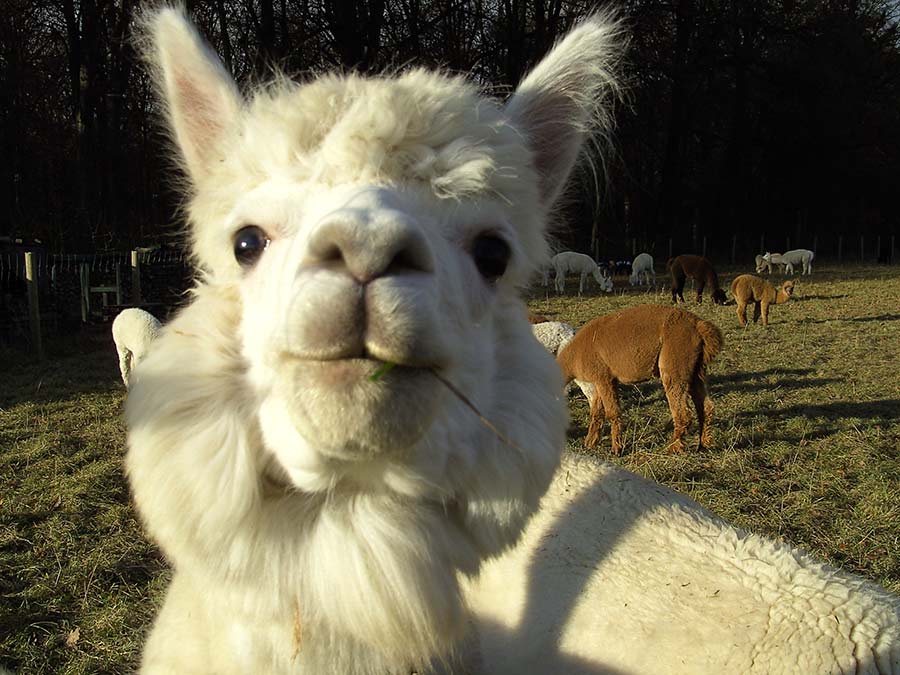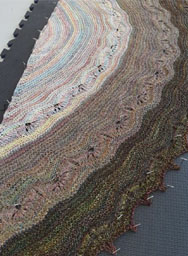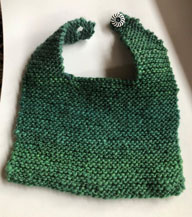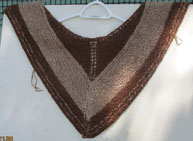What do you do with llama and alpaca fiber?

The Diversity of Llama and Alpaca Fiber
By Kathy Stanko
Chair, Fiber Committee
Towards the end of March 2020, I sent an email out to the RMLA Fiber Community: Good Morning everyone. So here we are, 'stuck in place' for the most part. For my part, I am thankful that I have 17 llamas that need attention: of every kind. This week I began working with 2 each day. It is fun and it gets me outside and I feel like I am getting something done. Each one requires a different type of attention. Some need to be reminded about haltering and walking, so I do that. We have a couple of skittish and head-shy guys. So I am using my Camelidynamics training to get them more comfortable with my presence.
Most need grooming. so I do what each can tolerate and remind them that I can touch everywhere on their bodies. My ultimate goal is to get them used to a lot of leg touching so I can cut out all the leg-wool mats! I feel like I have 6 months to get all those legs cleaned up! So far, I have 1 leg done on two different llamas. I have lots of time and patience!
Now, let's have some fun. What are you all doing to keep yourselves entertained during this time?
One good thing about lamas and alpacas fiber: you can go your own direction and do your own thing. Our members have not been going to fiber shows or festivals as they, too, have been cancelled and postponed. But our members have been fulfilling their passion for fiber in other ways. Read on.
From Katy White, Midway UT
I've inventoried and packaged my stock of roving, trying to be ready for whenever we can be out and about again. And I and my assistant website designer, Seamus, have spent a good deal of time updating the ranch website. The previous site was old and not mobile ready, so I've converted to a new theme and rebuilt the pages. Now I am trying to learn how to set up a Woocommerce shop for my llama products. See Katy’s article Plenty of Time to Build a New Website. (Webmaster note: search blog for Summer 2020 issue of the RMLA Journal.)
From Chris Switzer, Estes Park, CO
Very glad to have projects to work on. I spin a little, knit some, weave lots, and also work on hand picking fleece (reddish brown alpaca plus white Suri). I find I need to work with my hands. I need to think about something else besides the news. I need to look forward and keep a good attitude. With just 1 old llama plus 2 alpacas (1 old, 1 middle aged) we do not have many chores. The llama and alpacas are so happy to get onto the lawn in front of our house that has some new green grass!!
Imagine brown & white, 2 ply handspun alpaca yarn. It is variegated in an irregular color scheme. Some of the handspun is darkish, so put with dark brown alpaca yarn for warp. The other is lightish, so put with off-white warp. Woven for scarves, 10 epi in the reed, with a balanced beat so that both warp and weft show. The "look" of the scarves is texture, but they are smooth to the touch.
When you spin, just take a handful of the brown, then some white, and repeat in no particular order. Plying will also add to the variegation. For knitting, a 2 ply is needed; for weaving, a single can be used on the shuttle, or a 2 ply.
P.S. This alpaca was pinto with spots (!) and she had 1 male cria with the same colors.
From Nancy Wilson, Camp Verde, AZ
I have plenty of fiber projects to keep me busy! I have three knitting projects going. One is a handspun scarf using an alpaca/East Friesian wool blend that I dyed. Second is a capelet that I’m using some commercial spun Madeline Tosh yarn, and third is a KAL I’m doing with the Verde Valley Weavers and Spinners Guild. We’re all knitting the Odyssey shawl from Ravelry in different yarns.
Note: KAL is short for knit-along and is a group activity, where hundreds of knitters are working the same pattern at the same time. It is a great way to work a pattern with the support of hundreds of knitters all using different yarns.
Our plan is to display the shawls at the show we put up at the Sedona Public Library. I’m using handspun. It’s yarn I’ve spun drafting two fibers together. I’m using a dyed merino braid that I bought in Illinois last year visiting family. Then the other fibers are white Polwarth, tan llama/wool/mohair, and a dark gray llama/alpaca/wool blend.
Also, I’ve been watching some rigid heddle DVDs and hoping to get my loom warped soon. I’ll use commercial yarn for the warp and handspun for the weft. The Saori philosophy really resonates with me, so I’ll be weaving random yarns.
And finally, I am chair of the group planning Arizona Fiber Arts Retreat, to be held in Prescott, AZ, January 20-23, 2021. This is now an RMLA event so you will be receiving details as they become available.
From Lynda Liptak, Albuquerque, NM
I sure enjoyed reading your notes; you inspired me to send out a story as well. Albuquerque is greening up now and the llamas are getting more playful. I love watching them cavort around and pronk and play king of the hill on a small mound we made. We have 11 llamas now with 7 being recent (since late November) rescues (wild and two came in pregnant) and they need all the time I can offer. My volunteers and I have done a lot of gentle handling. Two just went on their first walk with training packs; I am very proud of their progress and the work we have done with them. I decided to keep these two so they are getting extra attention. I also use Camelidynamics techniques with a little blend of my own style. I plan to watch Marty’s online classes to keep motivated. Am sorry we have to wait a year before she comes back to the Santa Fe area.
I will need to shear these newbies soon and that will be a fun trial especially for the females who are pregnant and I feel challenged to gain their trust.
I did put my hands on my old stash of alpaca fiber just yesterday only to surrender it to SWLR for Baxter to felt up blankets. She has a new felting machine to try out. I tried to cram 27 lbs. into one large microwave box by squeezing out all the air I could and managed to hold the box closed with gorilla tape (lots of it). I know vacuum bags work nicely to compress and are good moth protection for carded and spun yarn, but they are pricey enough for me to keep them for just storage.
SWLR is a great cause I am happy to donate my precious fiber to and I need to recognize that I can’t get to everything I want to.
My daughter came in from San Francisco just before the city lock down and we quarantined together at home here in Albuquerque. She wanted to do a knitting project for her baby and my first grandchild! We knit up a couple of beautiful baby bibs (yes with wool - not cotton, although spinning cotton is fun too when I get a clean stash fresh from the field in Las Cruces, NM). They came out lovely. I had to start out with something simple before I do the baby sweater since I am a part time knitting practitioner with low end skill. I have so much handspun from past years my focus is to move it from hanging on my pegboard looking colorful to getting it on a body looking more gorgeous and useful.
From Kathy Stanko, Whitewater, CO
Our llamas are sheared! And during this process using scissors, electric clippers, and a lot of patience we now have many ‘naked’ legs! Still more ‘leg mats’ in my future but I will get there and soon the llamas’ legs will be mat-free.
I have been knitting shawlettes. These are not full-length shawls as I do not have the patience for that. Shawlette is smaller, more like a summer evening should wrap. Prior to this adventure, I had not knitted a triangle shawl. Once I got the hang of how you start one: creating a knitted tab of sorts at the top from which the entire thing grows before your very eyes. I am still learning about keeping my tension loose so the whole thing flows. The one in the photo has several rows of beaded yarn around the bottom. In the center, from top to bottom is about 16 inches. Please ignore the loose yarn that has not been tied off yet; a small detail that I put off until the very, very last possible moment.
Like this article? Become a RMLA Member today!




